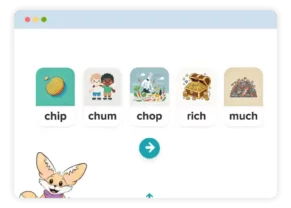At eSpark, we aim to not only teach students, but to engage them. We want to make learning inspiring, welcoming, and fun for students at all levels. To do this, we created Quests – online landscapes in which students learn and play simultaneously. Each educational research-based eSpark Quest consists of quizzes, instructional videos, activities, and games aligned to Common Core standards to reinforce and supplement lessons taught in class.
“Quests are a delicate combination of teacher intuition and data.”
– Mary Gurley
Director of Curriculum and Learning Design
Where does Quest creation begin?
To create fully adaptive, engaging Quests for students, we start with pedagogical research. Rigorous educational studies are the backbone of eSpark’s curriculum and design, and in 2021 eSpark was awarded Digital Promise’s Research-Based Design Product Certification in recognition of this research focus.
When creating a new Quest, our Learning Design team first unpacks the selected Reading or Math standard. We make sure we have a clear grasp of the standard and all of its different requirements and subskills. As the Quest begins to take shape, we then work backwards to ensure it contains all the necessary elements.
How are Quests adaptive?
Before students begin their first Quest, a quick initial assessment takes place.
“Using a district’s third-party data or eSpark’s own placement quiz, we assess each student’s individual learning needs. That data may tell us that within one classroom, one student’s needs are in fifth grade inferencing, while another student’s are in third grade multiplication,” Gurley said.
During the placement quiz, students are given a set of questions. Based on results from the first set of questions, students are moved to an easier or harder set to continue pinpointing their appropriate instructional level. The entire quiz only takes about 15 minutes to complete.
“From there, students are placed in their appropriate adaptive path within eSpark. As students embark on a Quest, bookended by pre- and post-quizzes, their data will tell us if we’ve placed a student in the right Quest. We are constantly adjusting based on what our data tells us their specific needs are,” Gurley added.
eSpark Quests are assessed every quarter for quality and student engagement. New content, such as games and poems, is constantly added to our curriculum to ensure maximum results in student success.
How is student engagement measured?
We hold Quest elements to a high standard. All activities and the individuals represented within them reflect the diversity of our students’ lives. They address skills in meaningful ways, encourage persistence, and spark curiosity while highlighting the joy of learning.
To determine if an activity meets these standards, we ask for student feedback. Students are always able to rate activities after completing them by simply selecting a thumbs-up or a thumbs-down. In order for an activity to remain in a Quest, it must meet an 85% student thumbs-up threshold.

What does a differentiated Reading or Math Quest look like?
While our Quests are created uniquely by grade and standard, each follows a specific formula designed to guide students toward skill mastery at their own level.
Pre-Quiz
Each Quest begins with a pre-quiz. This quiz consists of five to ten standards-based questions that assess student knowledge before beginning the lesson.
Framing Videos
These introductory videos are short and engaging. They offer a clear explanation of what the student will be learning and establish relevance and purpose for the lesson.
Instructional Videos
Each Quest features two to four videos that establish background knowledge. These videos provide explicit instruction and model the standard or skill for that Quest.
Practice Activities
Students are given various opportunities to practice their new skill or standard throughout their eSpark Quest. Interactive games, articles, images, graphic organizers, and more engage students while aiding retention.
Critical Thinking Challenges
Each eSpark Quest contains at least one Critical Thinking Challenge. These feature various types of prompts, such as categorizing, matching, or highlighting images, to provide an opportunity for higher order thinking. Students receive multiple chances to answer these questions correctly.
Post-Quiz
Like the pre-quiz, these assessments are made up of five to ten standards-based questions. They are used to measure growth from the beginning of the Quest to the end, and help determine where students adventure to next on their adaptive path.
Student Explanation of Learning / Student Video Recording
At the end of each eSpark Quest, students are offered the chance to show what they’ve learned to their own teacher. By recording themselves talking through the lesson they just learned, students become the teacher to demonstrate skill mastery and further support retention. Students then can receive written feedback from their teacher on their progress.
How are Quests used in the classroom?
Quests are different from teacher-assigned lessons which can be completed in one sitting and target a highly specific standard of the teachers’ choosing. Quests are fully adaptive to the students’ needs and can allow students to work at their own level, whether that’s below, at, or above grade level.
Quests are typically completed in one to two weeks. This allows students enough time to interact with a standard’s content and to demonstrate mastery. In general, it is recommended that students use eSpark for about 20 to 30 minutes, four times a week in both Reading and Math.
Click below to experience an activity from a student’s perspective.



